Note: When I first started blogging 19 months ago, I somewhat arbitrarily decided to post my photos at 720 pixels on the long side. It didn’t take me long to change my mind and begin posting significantly larger images for the much better quality that becomes apparent at that larger size. Since that time I’ve pretty much ignored those early posts, until yesterday when Ingrid Taylar brought my attention to this Great Horned Owl post and it reminded me just how small the images are. So, I’ve decided to repost a very few of those very early works, with some additions and changes which will include:
- larger images – 900 pixels on the long side
- additional images, in most cases
- techs included with the photos
- updated narrative
I’m thinking there might be two or three of these reposts over the next several weeks. I hope you’ll bear with me…
For many years now there has been at least one pair of nesting Great Horned Owls on the farm where I grew up near Cut Bank, Montana. They were never there when I was a kid but they’ve sure taken to it since. This farm still seems like home to me and I return to it at least once every year for a visit with family and of course to check up on the owls. It’s the perfect place for these birds as it’s isolated, there are many old barns and granaries for the owls to find sanctuary and the area is literally crawling with field mice, voles and the ubiquitous Richardson’s Ground Squirrel (gophers). Both the owls and I love the place!
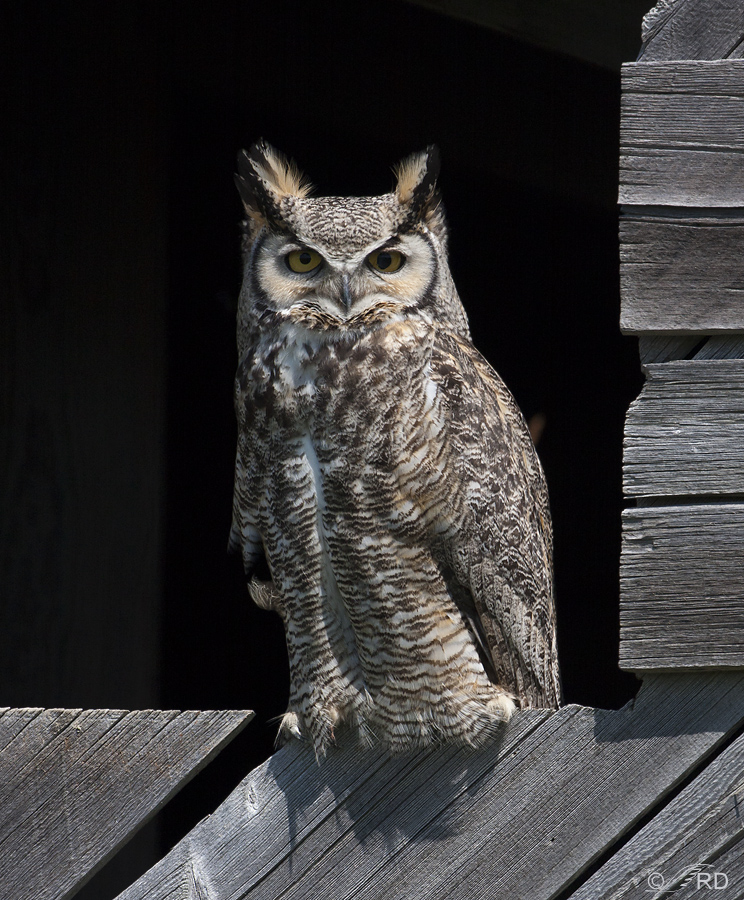
1/2000, f/8, ISO 500, 500 f/4, natural light, not baited, set up or called in
Most often I prefer my birds on natural perches but there’s just something about owls and old barn wood that appeals to me. I think owls, particularly Barn Owls and Great Horned Owls, often just seem to ”fit” in many rustic settings. In the image above, I like the relatively warm tones of the bird contrasting with the cooler tones of the black background and some of the wood. This was taken with the sun fairly high in the sky so the eyes are in shade.
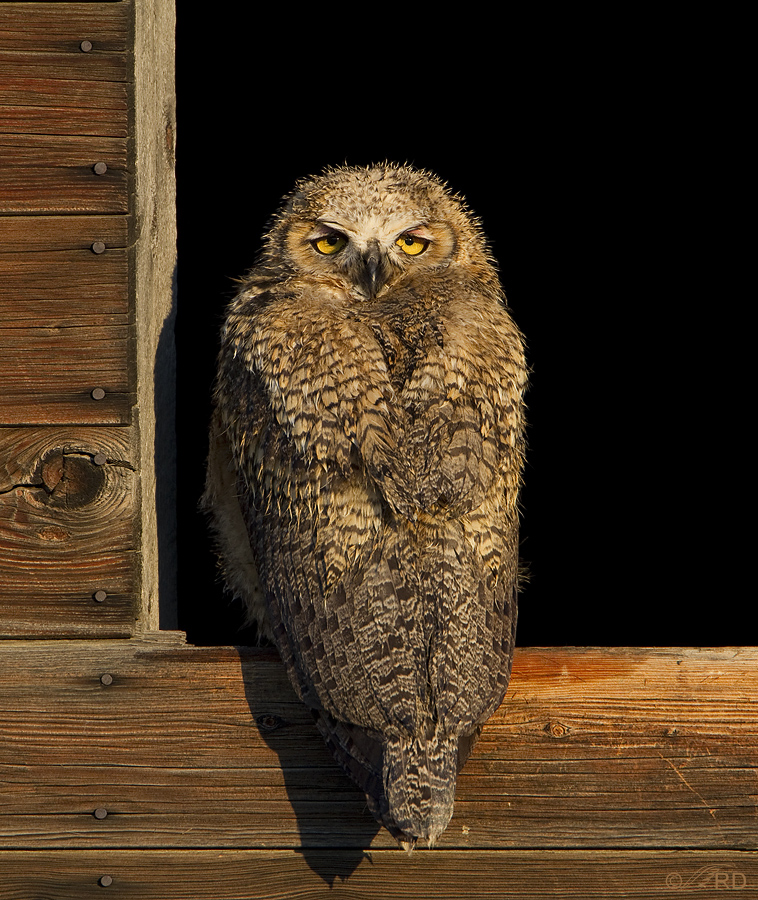
1/250, f/7.1, ISO 250, 500 f/4, 1.4 tc, natural light, not baited, set up or called in
This youngster was sitting in an east facing cutout of an old granary just as the sun came up. The effect of the warm light on both bird and wood is fairly dramatic (no saturation added). The bird is wet from the dew, thus the “spikiness” on the top of the head. They look very different from the adults before they develop their namesake horns.
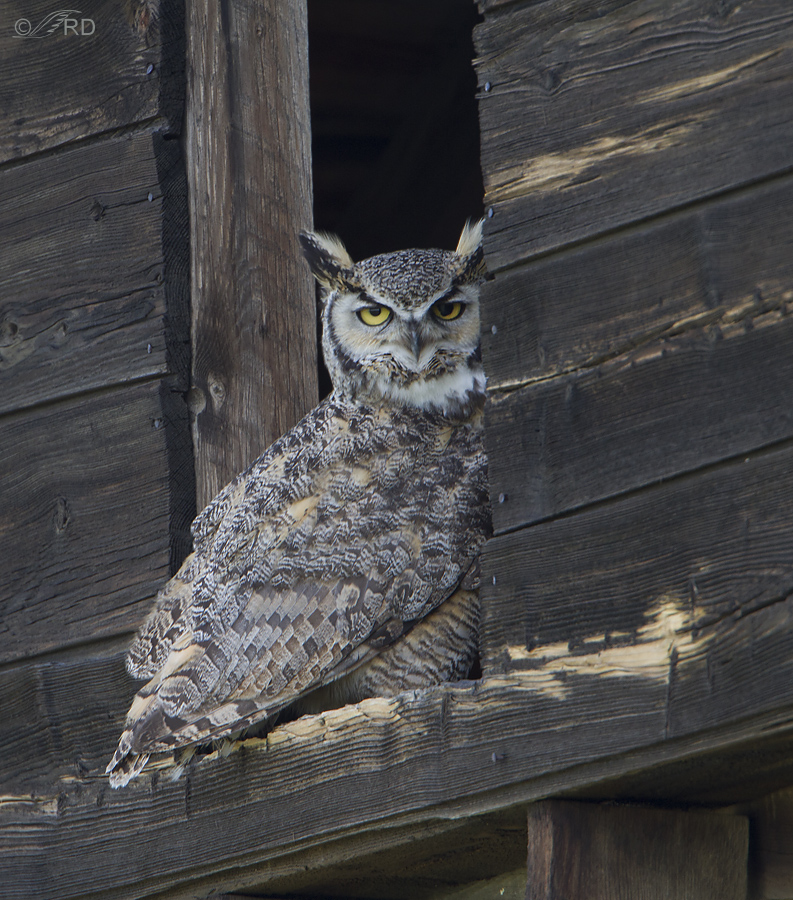
1/200, f/7.1, ISO 400, 500 f/4, 1.4 tc, natural light, not baited, set up or called in
This shot was taken in shade and part of the bird is obscured but I like the suspicious look I’m getting from the owl.
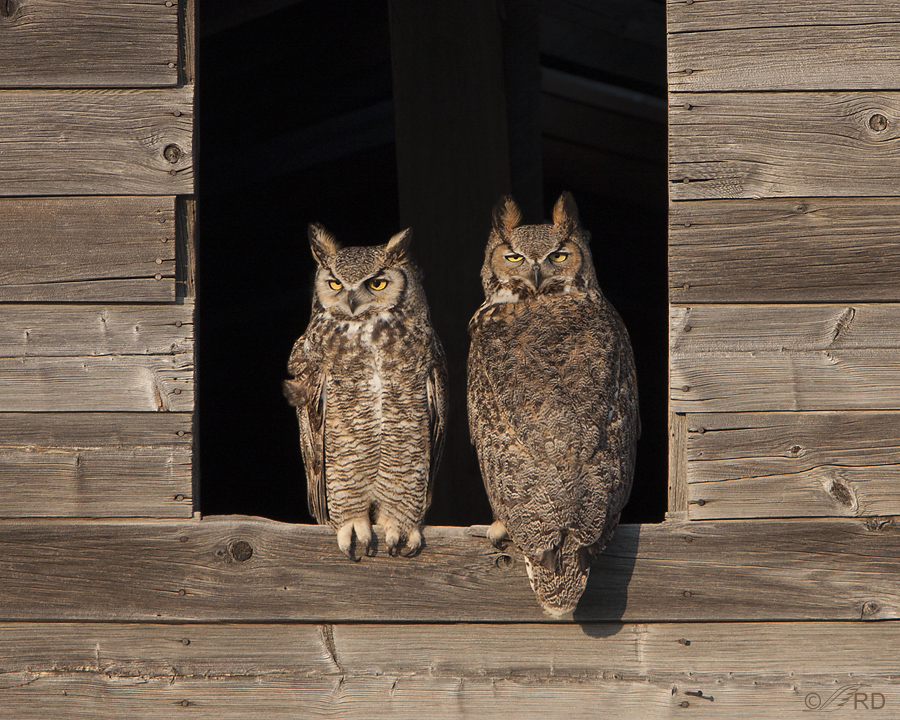
1/400, f/8, ISO 400, 500 f/4, 1.4 tc, natural light, not baited, set up or called in
This photo appeals to me for two reasons. It gives us a good look at both the front and back views of the species in one image and it so well illustrates reverse sexual dimorphism. Sexual dimorphism is a difference in form between males and females in the same species. In most birds, males are larger than females – one type of sexual dimorphism. Not so with these owls and most other raptors. In the image above, the female on the right is larger than the male on the left – thus reverse sexual dimorphism. There is still debate as to precisely why this trait was selected for in many raptor species.
It’s virtually impossible to tell the sex of a Great Horned Owl unless you can see both the adult male and female at the same time and compare their relative sizes.
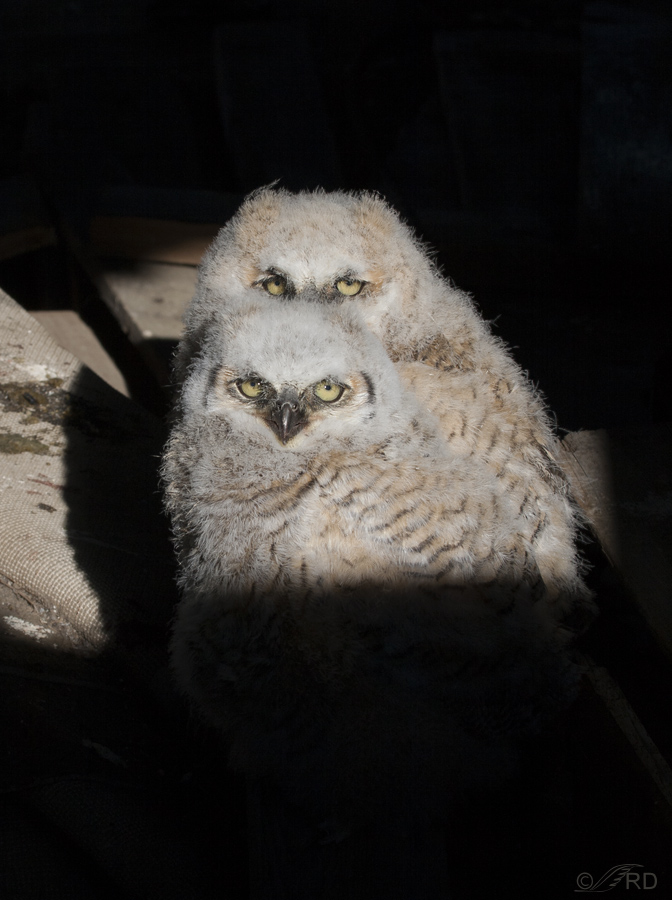
1/400, f/13, ISO 400, 100-400 @ 110 mm, natural light, not baited, set up or called in
Usually the owls raise their family up high among the rafters in one of the granaries or barns but one year they raised them on the floor of a cluttered old granary. I was surprised that predators didn’t take advantage of the situation but these two owlets thrived. GHO’s are known to be extremely aggressive in defending their nests and young and I suspect that fact may have played a role in the survival of these owlets.
Notice the eye color of these young birds compared to those of their parents. The eyes of chicks tend to be yellowish hazel at 2-3 weeks old, compared to the bright lemon chrome yellow of adults.
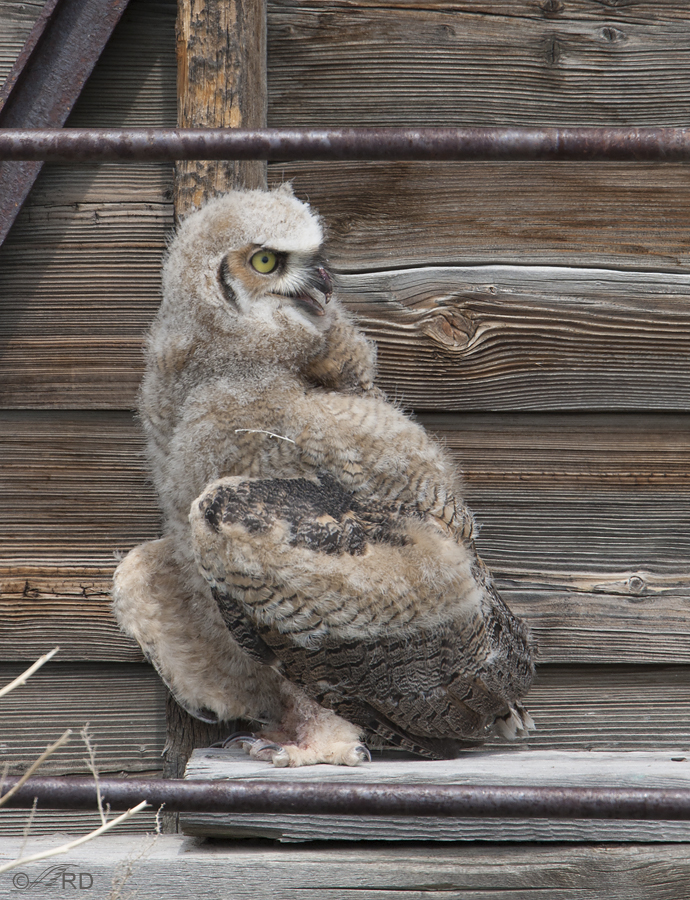
1/640, f/8, ISO 400, 500 f/4, 1.4 tc, natural light, not baited, set up or called in
The fledglings can fly at a surprisingly early stage, when they still look too gangly, awkward and undeveloped to do so. You never know where you will find one (or two), especially in the early morning. They seem to make a concerted effort to explore the farm as soon and as often as possible. It’s amazing where they turn up sometimes.
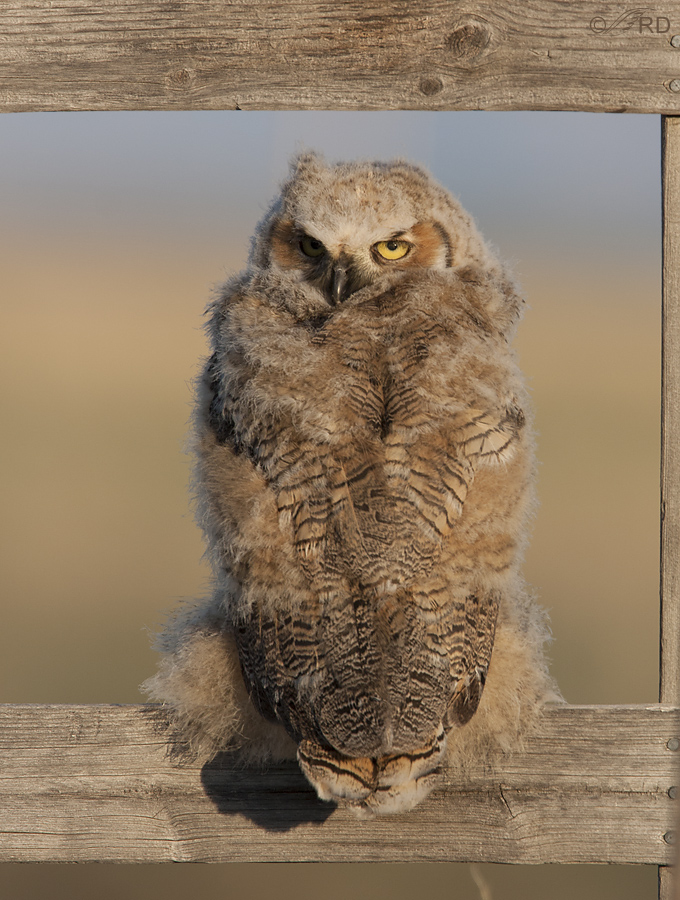
1/400, f/8, ISO 320, 500 f/4, 1.4 tc, natural light, not baited, set up or called in
I found this fledgling on a rung of an old wooden ladder just as the sun was rising in the east.
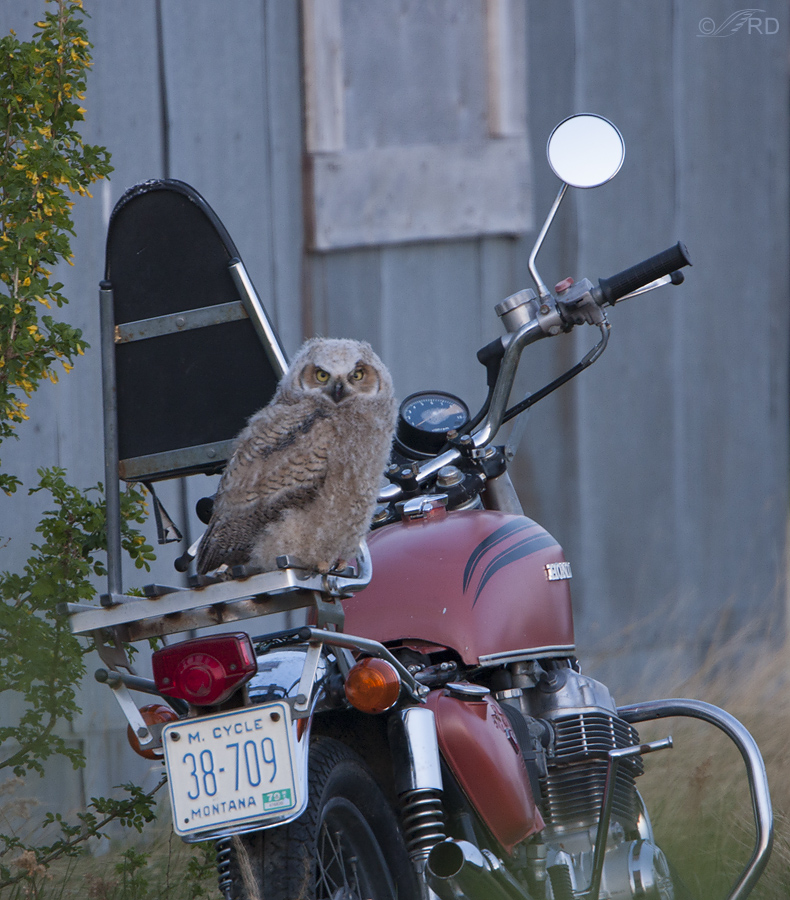
1/30, f/5.6, ISO 500, 500 f/4, 1.4 tc, natural light, not baited, set up or called in
This was taken before the sun came up. This youngster was perched on an old, junked motorcycle near the granaries that these birds feel so comfortable in. Even though I had very little light for this shot, it’s one of my very favorites, for sentimental reasons.
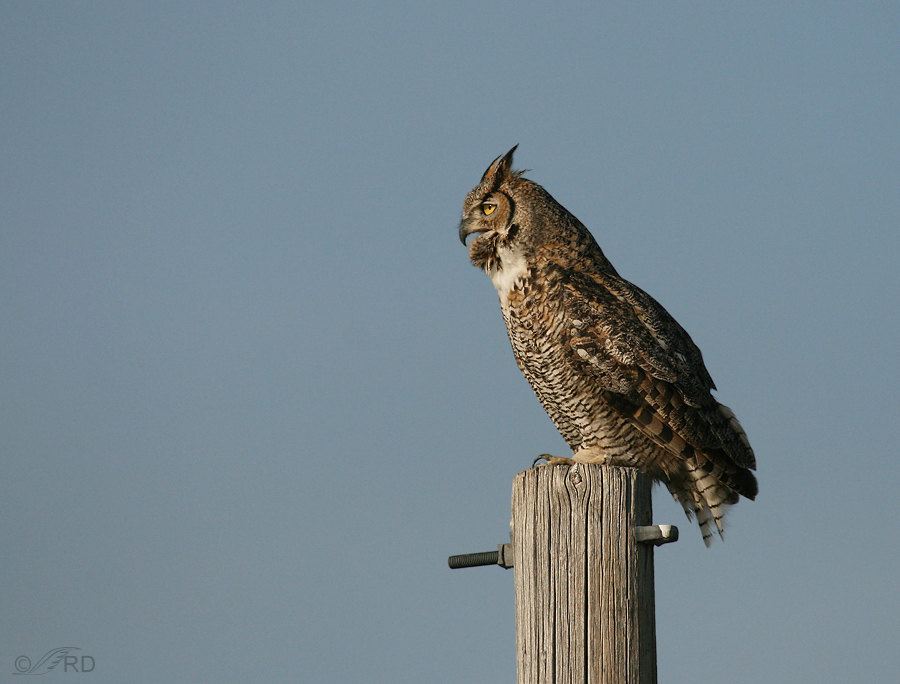
1/2500, f/7.1, ISO 400, 500 f/4, 1.4 tc, natural light, not baited, set up or called in
This adult liked to perch on a large wooden pole that is one of the supports for an old children’s “fort”.
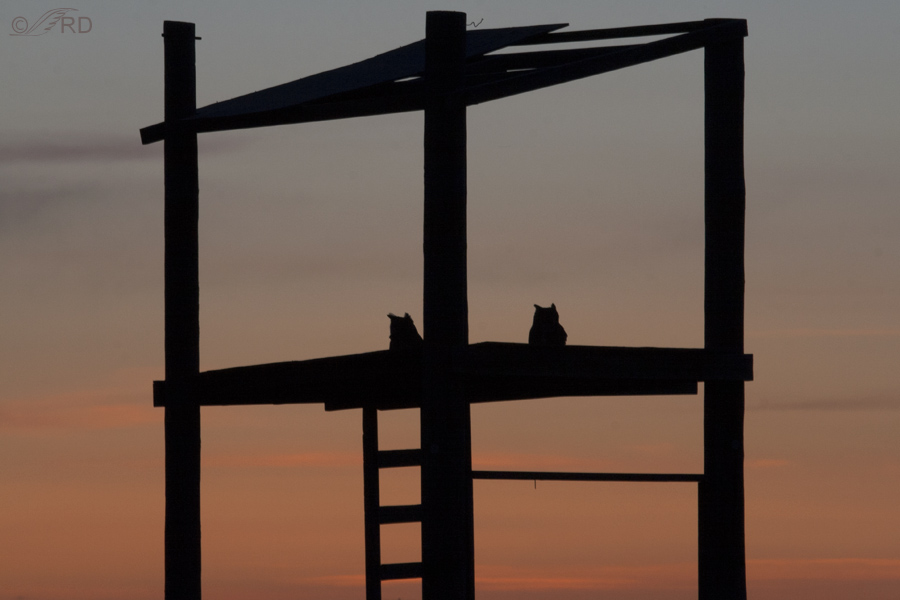
1/25, f/16, ISO 400, 100-400 @ 285 mm, natural light, not baited, set up or called in
Both adults are perched on the remnants of that old fort as they wait for dark to go hunting. The bird in the previous image was on top of the post on the left.
I really enjoy these owls every time I go “home”. They seem to add a certain character to the farm that I appreciate and so does everyone else in the family. It’s nice to know that in at least some situations, truly wild animals can coexist among humans – and even thrive.
Ron


Thank you so much for sharing your gift with us!
How lucky you were to grow up on that farm! I am glad the owls have a place to live and a friendly atmosphere in which to raise their young. These images are spectacular for their depiction of the fledglings and their surroundings. Thank you again for a great blog.
I really love this blog!
I really love that you love it, Teri! Thank you.
When I started my blog last summer, I was debating whether to post at 900px (horizontally), and 650px or so (vertically). But I decided to remain at 850px (horizontally), and 700px (vertically). The reason being that I lived in a place where I had to use a 3G Mi-Fi device, which is extremely slow in opening up large files. Now with a decent broadband Wi-Fi router, I can size my images much larger, but it makes me feel a bit bad for the people that have very poor Wi-Fi signals or use 3G or 4G devices. I imagine they would have a hard time opening up large files. What do you think?
Maria, I debated the same thing when I started blogging. That’s one of the reasons I started out posting 720 pixel images – especially given the fact that my posts sometimes have up to a dozen images. Admittedly it’s a tradeoff, but in the end I decided I’d rather have my images look as good as they reasonably could, at the expense of some extra download time for some folks with slower service.
Thanks, Ron. I always thought that I was doing it right, but it’s always nice to hear others’ input.
Great series of images, Ron. Outstanding. One question on your image size. You mention the size, so what resolution to you publish them at? I have been publishing mine at 72 res. I understand that this is the best for the web.
Thanks, Bob. It’s my understanding that, no matter what resolution you save at, IE only displays at 72dpi.
As I have said before I have a huge weakness for owls. They would make any day I was privileged enough to see them. Thank you so much for these, essentially I drooled over them all.
And yes, your posts are always an education and a delight.
I don’t think a little drool will hurt them a bit, Elephant’s Child. Thank you.
Awesome photo of the pair of owls which so well illustrates, as you say, reversed size dimorphism. Is there any way we can ‘like’ and share that on facebook? Or could I get your permission (and a copy) to use in our class we give to our volunteers?
Thank you, Louise. There’s a “Share on Facebook” (and other social media) icon right after my name at the bottom of each post. If that doesn’t work well for you, let me know and I’ll send you a copy you can use for that purpose.
How wonderful! Thanks for sharing! I never see owls and have tried to find them. We had one at our home over 20 years ago and I fell in love with the lady (a great horned) and have never seen one since except at the World Bird Center. How I would love to see these wonderful owls in their own habitat!
Owls, perfect images, great information and technical details — what’s not to like??
As I’m sure you’re aware, since finding your site a few weeks ago I have been using it as a learning tool. Feel free to send me your bill for instruction!
Simply wonderful stuff. Thank you.
–Wally
Wally, Your “bill” is more than paid up by your support of my blog with your comments! I’m delighted to hear that you find the posts helpful.
Ron,
Your aesthetic is perfect, as is your vision. I appreciate your commitment to honesty in your work…it is utterly refreshing actually!. There are many reasons your stunning photos are appealing…
Thanks very much, Blue Page.
Positively captivating!
Thank you, Chuck.